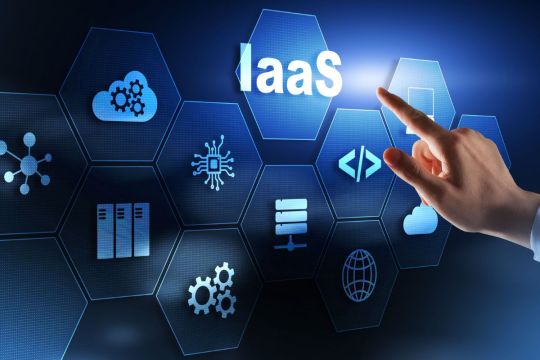#Cloud Computing Trends
Explore tagged Tumblr posts
Text
How Cloud Computing Trends Are Driving Innovation in SaaS, PaaS, and IaaS Solutions?

Businesses, nowadays, cannot function without the availability of cloud computing. It has become the backbone of innovation for businesses across industries. Cloud computing trends are not only reshaping how organizations manage their IT infrastructure, but they are also driving significant advancements in key service models like Software as a Service (SaaS), Platform as a Service (PaaS), and Infrastructure as a Service (IaaS). Without the prevailing technology adaptation in the cloud computing aspect it has become impossible for businesses to function productively & efficiently.
The Rise of Cloud Computing: A Foundation for Innovation
Cloud computing has revolutionized how companies operate by providing scalable, flexible, and cost-effective solutions. The core appeal of cloud computing lies in its ability to reduce the complexity and high capital costs associated with traditional on-premise IT infrastructure. Through cloud platforms, businesses can access advanced technologies, large-scale computing power, and sophisticated data storage systems without the need for significant upfront investments.
However, the impact of cloud computing trends extends far beyond cost savings. The continuous innovation in cloud technology is enabling businesses to push the boundaries of what��s possible, particularly in SaaS, PaaS, and IaaS solutions. Let’s explore how these three service models are being transformed by the latest cloud computing trends.
1. SaaS: Powering Businesses with Cloud-Native Applications

Software as a Service (SaaS) is one of the most prominent cloud-based service models, offering businesses access to software applications hosted on the cloud. As cloud computing continues to evolve, SaaS solutions are becoming increasingly robust, accessible, and flexible. Key cloud computing trends driving innovation in SaaS include:
AI and Automation Integration
Artificial intelligence (AI) and machine learning (ML) are two of the most influential technologies currently shaping SaaS platforms. With the help of cloud infrastructure, SaaS providers can now incorporate advanced AI and automation features that improve productivity and streamline business processes. For example, CRM platforms like Salesforce are leveraging AI to predict customer behavior, automate workflows, and provide personalized user experiences.
The increasing integration of AI in SaaS applications is transforming industries such as marketing, finance, and healthcare, where organizations can now utilize predictive analytics and automate complex processes with minimal human intervention. By adopting these computing trends like AI and automation, businesses can gain a competitive advantage by offering smarter, more efficient software solutions.
Low-Code/No-Code Development
Another cloud computing trend influencing SaaS is the rise of low-code/no-code platforms. These platforms enable business users without extensive coding knowledge to create custom applications or workflows. By democratizing app development, low-code/no-code tools are accelerating innovation within organizations, allowing teams to quickly prototype and deploy software solutions tailored to their specific needs.
For SaaS providers, offering low-code or no-code development tools as part of their platform makes it easier for businesses to innovate and adapt their software to changing requirements. This trend is significantly reducing the time and cost associated with software development and customization.
2. PaaS: Accelerating Application Development and Deployment

Platform as a Service (PaaS) provides businesses with the tools and frameworks necessary to develop, test, and deploy applications without the complexity of managing underlying infrastructure. Cloud computing trends are playing a pivotal role in enhancing PaaS offerings, allowing businesses to accelerate application development and reduce time-to-market. Key trends include:
Serverless Computing
One of the most groundbreaking trends in PaaS is serverless computing, which is making it easier for businesses to develop applications without the need to manage servers. In a serverless architecture, developers can focus solely on writing code while the cloud provider automatically handles the provisioning, scaling, and management of the servers.
This trend is reducing the complexity and operational overhead associated with application deployment, allowing businesses to quickly scale their applications based on demand. Serverless computing is ideal for businesses that need to deploy applications with unpredictable workloads or fluctuating user traffic. With this model, organizations can optimize costs, as they only pay for the resources they actually use.
Containerization and Kubernetes
Containers and container orchestration tools like Kubernetes are rapidly gaining traction within PaaS environments. Containers enable businesses to package applications and their dependencies into a single unit that can run consistently across any environment, whether on-premise or in the cloud.
Kubernetes, an open-source container orchestration platform, automates the deployment, scaling, and management of containerized applications. This trend is revolutionizing how businesses develop and manage applications by providing a scalable, efficient, and portable environment for developers.
As businesses continue to adopt cloud computing trends like containerization and Kubernetes, they are able to deliver more reliable applications faster, streamline their development processes, and scale with greater agility.
3. IaaS: Revolutionizing IT Infrastructure

Infrastructure as a Service (IaaS) provides businesses with virtualized computing resources over the internet, allowing them to scale IT infrastructure as needed. These computing trends are reshaping IaaS offerings, providing businesses with new ways to optimize infrastructure and reduce operational costs. Key trends include:
Edge Computing
One of the most exciting cloud computing trends in IaaS is the rise of edge computing. Edge computing involves processing data closer to where it is generated (i.e., at the "edge" of the network), rather than relying solely on centralized cloud data centers. This approach reduces latency and bandwidth costs, making it ideal for applications that require real-time data processing, such as autonomous vehicles, IoT devices, and industrial automation.
By leveraging edge computing, businesses can create more responsive, efficient systems that provide a better user experience. This trend is driving innovation across industries such as manufacturing, logistics, and healthcare, where real-time data processing is critical.
Hybrid and Multi-Cloud Architectures
While cloud computing has been largely about public cloud solutions, many organizations are adopting hybrid and multi-cloud strategies to improve flexibility, security, and risk management. In a hybrid cloud environment, businesses use a combination of on-premises infrastructure and cloud resources, allowing them to choose the best solution for each workload. Multi-cloud architectures involve using services from multiple cloud providers to avoid vendor lock-in and optimize performance.
These computing trends are providing businesses with more control over their IT environments while offering the scalability and flexibility of cloud infrastructure. Hybrid and multi-cloud strategies also enhance business continuity by distributing workloads across different cloud providers, reducing the risk of downtime in case of a failure at one provider.
The Business Impact on SaaS, PaaS, and IaaS
For business leaders, the growing sophistication of cloud computing trends presents significant opportunities to drive innovation, streamline operations, and reduce costs. By leveraging cloud computing trends, organizations can:
Achieve Greater Agility: Cloud computing enables faster development cycles, allowing businesses to respond more quickly to market changes, customer needs, and technological advances.
Improve Scalability: With cloud solutions, businesses can scale their IT infrastructure, applications, and services as needed, ensuring they can handle increasing demands without over-investing in resources.
Optimize Costs: The pay-as-you-go nature of cloud services, combined with advanced automation and serverless technologies, helps businesses optimize operational costs by only paying for the resources they use.
Enhance Security and Compliance: Cloud providers are investing heavily in security and compliance features, offering businesses the tools they need to protect sensitive data and meet regulatory requirements.
Conclusion
The continuous evolution of cloud computing trends is driving innovation across SaaS, PaaS, and IaaS solutions, creating new opportunities for businesses to leverage cloud technologies for greater efficiency, agility, and scalability. As these trends continue to shape the cloud computing landscape, organizations that embrace them will be better equipped to stay competitive, streamline operations, and innovate faster.
Uncover the latest trends and insights with our articles on Visionary Vogues
0 notes
Text
Breaking into the Cloud Computing and DevOps Field: Where to Start?

The tech landscape is rapidly transforming, with cloud computing and DevOps at the forefront of this evolution. As businesses increasingly migrate their operations to the cloud and adopt agile practices, the demand for skilled professionals in these areas continues to rise. If you’re looking to break into this exciting field, one of the best first steps is to enroll in a cloud computing institute in Hyderabad. Here’s how to get started on your journey.
Understanding the Basics
Before diving into a career in cloud computing and DevOps, it’s essential to understand what these fields entail. Cloud computing involves delivering various services, such as storage, databases, and software, over the internet, enabling businesses to operate more efficiently. DevOps is a set of practices that integrates software development (Dev) and IT operations (Ops), fostering collaboration and streamlining workflows.
Understanding these concepts in cloud computing institute in Hyderabad lays the foundation for your career. Once you grasp the basics, you can focus on acquiring the necessary skills and knowledge.
Choosing the Right Cloud Computing Institute in Hyderabad
Selecting a reputable cloud computing institute in Hyderabad is crucial for your education and future career. Look for institutes that offer:
Comprehensive Curriculum: Ensure the program covers essential topics such as cloud service models (IaaS, PaaS, SaaS), deployment models, cloud security, and fundamental DevOps practices.
Hands-On Training: Practical experience is vital. Choose institutes that offer labs, projects, and internships to apply theoretical knowledge in real-world scenarios.
Industry Recognition: Look for programs that are well-regarded in the industry, ideally with partnerships or collaborations with leading tech companies.
Experienced Instructors: Learn from professionals with real-world experience who can provide valuable insights and mentorship.
Certifications: Opt for institutes that prepare you for industry-recognized certifications, such as AWS Certified Solutions Architect or Microsoft Certified: Azure Fundamentals. These credentials enhance your employability and credibility.
Building Your Skill Set
Once you’ve enrolled in a cloud computing institute in Hyderabad, focus on building your skill set. Key areas to concentrate on include:
Cloud Platforms: Familiarize yourself with major cloud service providers like AWS, Microsoft Azure, and Google Cloud. Understanding their services and offerings will give you a competitive edge.
Networking and Security: Learn about network configurations, security protocols, and compliance standards relevant to cloud environments.
DevOps Tools: Gain proficiency in popular DevOps tools such as Docker, Kubernetes, Jenkins, and Git. These tools are essential for automating processes and enhancing collaboration.
Scripting and Automation: Basic programming and scripting skills (Python, Bash, etc.) can significantly enhance your ability to automate tasks and manage cloud resources efficiently.
Gaining Practical Experience
Practical experience is crucial for solidifying your understanding and enhancing your resume. Participate in internships or collaborative projects during your training. Many cloud computing institutes in Hyderabad offer internship placements that can provide invaluable experience.
Additionally, consider contributing to open-source projects or creating your own projects. This hands-on experience not only helps you apply your skills but also demonstrates your initiative and problem-solving capabilities to potential employers.
Networking and Building Connections
Networking is essential in the tech industry. Attend workshops, webinars, and local meetups to connect with professionals and peers. Joining online forums and social media groups focused on cloud computing and DevOps can also help you stay updated on industry trends and job opportunities.
Leverage platforms like LinkedIn to showcase your skills, share your projects, and engage with industry leaders. Building a strong professional network can lead to mentorship opportunities and job referrals.
Exploring Career Opportunities
Once you’ve completed your training from cloud computing institute in Hyderabad and gained practical experience, it’s time to explore career opportunities. The job market for cloud computing and DevOps professionals is robust, with various roles available, including:
Cloud Engineer: Responsible for managing and implementing cloud services and solutions.
DevOps Engineer: Focuses on integrating development and operations to improve deployment efficiency and reliability.
Cloud Architect: Designs and oversees cloud infrastructure and strategy.
Site Reliability Engineer (SRE): Ensures systems' reliability and performance through proactive monitoring and incident management.
Many organizations are actively seeking talent in these roles, offering competitive salaries and benefits.
Continuous Learning and Development
The tech landscape is ever-evolving, making continuous learning vital. After starting your career, consider pursuing additional certifications or advanced training programs to keep your skills updated. This commitment to learning will enhance your career trajectory and keep you relevant in a competitive job market.
Conclusion
Breaking into the cloud computing and DevOps field may seem daunting, but with the right approach, it can be an exciting and rewarding journey. Start by enrolling in a reputable cloud computing institute in Hyderabad to gain the foundational knowledge and skills necessary for success. Focus on building your expertise, gaining practical experience, and networking within the industry. By taking these steps, you’ll be well on your way to establishing a fulfilling career in these dynamic and in-demand fields. Embrace the challenge, and you’ll find a world of opportunities waiting for you!
#technology#ai#devops#aws#Cloud Computing#cloud computing course in mumbai#cloud computing trends#cloud computing certification#cloud computing market#cloud computing training#cloud computing jobs#cloud computing course#DevOps#aws devops course in hyderabad#devops certification#DevOps training#DevOps course#DevOps training in hyderabad#aws training in hyderabad#aws cloud#aws certification#aws course
0 notes
Text
5 Key Cloud Computing Trends to Watch

Stay ahead of the curve with the latest cloud computing trends. Explore the top 5 key trends shaping the future of cloud technology, including AI integration, multi-cloud strategies, and enhanced security solutions for businesses. Visit now to read 5 Key Cloud Computing Trends to Watch
#Cloud Computing Trends#cloud computing industry#Edge Computing#Multi-Cloud Strategies#Hybrid Cloud Strategies#Serverless Computing#serverless computing benefits#hybrid cloud#hybrid cloud solutions#future of cloud computing#trends in cloud computing#hybrid cloud computing trends
0 notes
Text
Healthcare Cloud Computing Market Share, Key Market Players, Trends & Forecast, 2024–2030
The Healthcare Cloud Computing Market was valued at USD 43.9 billion in 2023-e and will surpass USD 133.1 billion by 2030; growing at a CAGR of 17.1% during 2024 - 2030. The report focuses on estimating the current market potential in terms of the total addressable market for all the segments, sub-segments, and regions.
In the process, all the high-growth and upcoming technologies were identified and analyzed to measure their impact on the current and future market. The report also identifies the key stakeholders, their business gaps, and their purchasing behavior. This information is essential for developing effective marketing strategies and creating products or services that meet the needs of the target market.
Get a Sample Report: https://bit.ly/4c7Zpo1
Key Drivers of the Healthcare Cloud Computing Market
Several factors are propelling the growth of the healthcare cloud computing market:
Data Explosion: The exponential increase in healthcare data, generated from electronic health records (EHRs), wearable devices, and medical imaging, necessitates scalable and efficient data storage solutions. Cloud computing offers virtually unlimited storage capacity, making it an ideal solution for managing large volumes of data.
Cost Efficiency: Traditional on-premise data centers require substantial capital investment and ongoing maintenance costs. Cloud computing reduces these expenses by offering pay-as-you-go models, allowing healthcare organizations to scale resources according to their needs.
Interoperability and Collaboration: Cloud platforms facilitate seamless data sharing and collaboration among healthcare providers, researchers, and patients. This interoperability enhances care coordination, leading to improved patient outcomes.
Regulatory Compliance: Cloud service providers are increasingly focusing on compliance with healthcare regulations such as HIPAA in the United States and GDPR in Europe. This focus ensures that patient data is stored and processed securely, adhering to stringent regulatory standards.
Technological Advancements: Innovations in artificial intelligence (AI), machine learning (ML), and big data analytics are driving the adoption of cloud computing in healthcare. These technologies enable predictive analytics, personalized medicine, and efficient resource management.
Benefits of Cloud Computing in Healthcare
The integration of cloud computing in healthcare offers numerous advantages:
Enhanced Data Security: Cloud service providers invest heavily in security measures, including encryption, firewalls, and multi-factor authentication, to protect sensitive healthcare data from breaches and cyberattacks.
Improved Accessibility: Cloud-based systems allow healthcare professionals to access patient data from anywhere, at any time. This accessibility is particularly beneficial for telemedicine, remote patient monitoring, and emergency care.
Scalability and Flexibility: Healthcare organizations can easily scale their IT infrastructure up or down based on demand. This flexibility is crucial in managing peak loads during public health emergencies, such as the COVID-19 pandemic.
Cost Savings: By eliminating the need for physical servers and reducing IT overhead, cloud computing helps healthcare providers save on operational costs. The subscription-based pricing models further enhance cost predictability.
Streamlined Operations: Cloud-based solutions enable the integration of various healthcare applications, such as EHRs, billing systems, and clinical decision support tools, streamlining operations and improving workflow efficiency.
Get an insights of Customization: https://bit.ly/4fnKRn6
Challenges in the Healthcare Cloud Computing Market
Despite its numerous benefits, the adoption of cloud computing in healthcare faces several challenges:
Data Privacy Concerns: Ensuring the privacy and confidentiality of patient data remains a top priority. Healthcare organizations must carefully select cloud service providers that comply with regulatory requirements and offer robust security measures.
Interoperability Issues: While cloud computing promotes data sharing, achieving true interoperability between different systems and platforms can be complex. Standardization efforts are needed to ensure seamless data exchange.
Reliability and Downtime: The dependence on cloud services raises concerns about reliability and potential downtime. Healthcare providers must have contingency plans in place to maintain continuity of care in case of service disruptions.
Resistance to Change: The transition to cloud computing requires a cultural shift and training for healthcare staff. Resistance to change and lack of technical expertise can hinder adoption.
Cost of Migration: Migrating existing systems and data to the cloud can be costly and time-consuming. Healthcare organizations must carefully plan and budget for the transition to minimize disruptions.
Future Prospects of Healthcare Cloud Computing
The future of healthcare cloud computing looks promising, with several trends poised to shape the market:
AI and Machine Learning Integration: The integration of AI and ML in cloud platforms will enable advanced analytics, predictive modeling, and personalized treatment plans, enhancing patient care and operational efficiency.
Expansion of Telehealth: The COVID-19 pandemic accelerated the adoption of telehealth services. Cloud computing will continue to support the growth of telehealth by providing the necessary infrastructure for remote consultations and monitoring.
Blockchain Technology: Blockchain has the potential to enhance data security and integrity in healthcare cloud computing. It can provide a tamper-proof record of patient data, ensuring transparency and trust.
IoT and Wearable Devices: The proliferation of Internet of Things (IoT) devices and wearables will generate vast amounts of health data. Cloud computing will play a crucial role in storing, processing, and analyzing this data to provide actionable insights.
Global Collaboration: Cloud platforms will facilitate global collaboration in medical research and clinical trials. Researchers can share data and findings across borders, accelerating the development of new treatments and therapies.
Conclusion
The Healthcare Cloud Computing Market is poised for substantial growth, driven by the need for scalable data storage, cost efficiency, and technological advancements. While challenges such as data privacy and interoperability remain, the benefits of cloud computing in healthcare are undeniable. As the industry continues to evolve, cloud computing will play a pivotal role in transforming healthcare delivery, improving patient outcomes, and driving innovation. Healthcare providers must embrace this technological shift to stay competitive and provide the best possible care to their patients.
0 notes
Text

Stay ahead with the top cloud computing trends in 2024. Explore key insights, innovations, and forecasts shaping the future of cloud computing.
0 notes
Text
#infiniticube#cloud application development companies#cloud computing developers#cloud computing development services#Cloud Computing Trends
0 notes
Text
AI to Hybrid: Hot cloud computing trends in 2024

Enterprises worldwide are embracing cloud computing as this is more efficient, reliable, agile, and secure than on-premises systems. Two-thirds of enterprises are running their infrastructure on cloud and this number is growing rapidly. Gartner predicted the worldwide public-cloud spending to be $600 billion in 2023.
0 notes
Text
Cloud & Devops Services | Nitor Infotech
In today's fast-paced digital landscape, cloud technology has emerged as a transformative force that empowers organizations to innovate, scale and adapt like never before. To know more about Nitor Infotech's services click on - https://bitly.ws/Zyt3
#nitorinfotech#blog#nitor#software development#software engineering#digital transformation#cloud computing#cloud software#clouds#cloudcore#cloud storage#cloud storage services#cloud computing trends#google cloud console#google cloud platform#google cloud#ascendion#gcp cloud vision#pillars of cloud#cloud engineering services#aws cloud migration services#what is cloud data storage#cloud pillar
0 notes
Text

AI’s Role in Business Process Automation
Automation has come a long way from simply replacing manual tasks with machines. With AI stepping into the scene, business process automation is no longer just about cutting costs or speeding up workflows—it’s about making smarter, more adaptive decisions that continuously evolve. AI isn't just doing what we tell it; it’s learning, predicting, and innovating in ways that redefine how businesses operate.
From hyperautomation to AI-powered chatbots and intelligent document processing, the world of automation is rapidly expanding. But what does the future hold?
What is Business Process Automation?
Business Process Automation (BPA) refers to the use of technology to streamline and automate repetitive, rule-based tasks within an organization. The goal is to improve efficiency, reduce errors, cut costs, and free up human workers for higher-value activities. BPA covers a wide range of functions, from automating simple data entry tasks to orchestrating complex workflows across multiple departments.
Traditional BPA solutions rely on predefined rules and scripts to automate tasks such as invoicing, payroll processing, customer service inquiries, and supply chain management. However, as businesses deal with increasing amounts of data and more complex decision-making requirements, AI is playing an increasingly critical role in enhancing BPA capabilities.
AI’s Role in Business Process Automation
AI is revolutionizing business process automation by introducing cognitive capabilities that allow systems to learn, adapt, and make intelligent decisions. Unlike traditional automation, which follows a strict set of rules, AI-driven BPA leverages machine learning, natural language processing (NLP), and computer vision to understand patterns, process unstructured data, and provide predictive insights.
Here are some of the key ways AI is enhancing BPA:
Self-Learning Systems: AI-powered BPA can analyze past workflows and optimize them dynamically without human intervention.
Advanced Data Processing: AI-driven tools can extract information from documents, emails, and customer interactions, enabling businesses to process data faster and more accurately.
Predictive Analytics: AI helps businesses forecast trends, detect anomalies, and make proactive decisions based on real-time insights.
Enhanced Customer Interactions: AI-powered chatbots and virtual assistants provide 24/7 support, improving customer service efficiency and satisfaction.
Automation of Complex Workflows: AI enables the automation of multi-step, decision-heavy processes, such as fraud detection, regulatory compliance, and personalized marketing campaigns.
As organizations seek more efficient ways to handle increasing data volumes and complex processes, AI-driven BPA is becoming a strategic priority. The ability of AI to analyze patterns, predict outcomes, and make intelligent decisions is transforming industries such as finance, healthcare, retail, and manufacturing.
“At the leading edge of automation, AI transforms routine workflows into smart, adaptive systems that think ahead. It’s not about merely accelerating tasks—it’s about creating an evolving framework that continuously optimizes operations for future challenges.”
— Emma Reynolds, CTO of QuantumOps
Trends in AI-Driven Business Process Automation
1. Hyperautomation
Hyperautomation, a term coined by Gartner, refers to the combination of AI, robotic process automation (RPA), and other advanced technologies to automate as many business processes as possible. By leveraging AI-powered bots and predictive analytics, companies can automate end-to-end processes, reducing operational costs and improving decision-making.
Hyperautomation enables organizations to move beyond simple task automation to more complex workflows, incorporating AI-driven insights to optimize efficiency continuously. This trend is expected to accelerate as businesses adopt AI-first strategies to stay competitive.
2. AI-Powered Chatbots and Virtual Assistants
Chatbots and virtual assistants are becoming increasingly sophisticated, enabling seamless interactions with customers and employees. AI-driven conversational interfaces are revolutionizing customer service, HR operations, and IT support by providing real-time assistance, answering queries, and resolving issues without human intervention.
The integration of AI with natural language processing (NLP) and sentiment analysis allows chatbots to understand context, emotions, and intent, providing more personalized responses. Future advancements in AI will enhance their capabilities, making them more intuitive and capable of handling complex tasks.
3. Process Mining and AI-Driven Insights
Process mining leverages AI to analyze business workflows, identify bottlenecks, and suggest improvements. By collecting data from enterprise systems, AI can provide actionable insights into process inefficiencies, allowing companies to optimize operations dynamically.
AI-powered process mining tools help businesses understand workflow deviations, uncover hidden inefficiencies, and implement data-driven solutions. This trend is expected to grow as organizations seek more visibility and control over their automated processes.
4. AI and Predictive Analytics for Decision-Making
AI-driven predictive analytics plays a crucial role in business process automation by forecasting trends, detecting anomalies, and making data-backed decisions. Companies are increasingly using AI to analyze customer behaviour, market trends, and operational risks, enabling them to make proactive decisions.
For example, in supply chain management, AI can predict demand fluctuations, optimize inventory levels, and prevent disruptions. In finance, AI-powered fraud detection systems analyze transaction patterns in real-time to prevent fraudulent activities. The future of BPA will heavily rely on AI-driven predictive capabilities to drive smarter business decisions.
5. AI-Enabled Document Processing and Intelligent OCR
Document-heavy industries such as legal, healthcare, and banking are benefiting from AI-powered Optical Character Recognition (OCR) and document processing solutions. AI can extract, classify, and process unstructured data from invoices, contracts, and forms, reducing manual effort and improving accuracy.
Intelligent document processing (IDP) combines AI, machine learning, and NLP to understand the context of documents, automate data entry, and integrate with existing enterprise systems. As AI models continue to improve, document processing automation will become more accurate and efficient.
Going Beyond Automation
The future of AI-driven BPA will go beyond automation—it will redefine how businesses function at their core. Here are some key predictions for the next decade:
Autonomous Decision-Making: AI systems will move beyond assisting human decisions to making autonomous decisions in areas such as finance, supply chain logistics, and healthcare management.
AI-Driven Creativity: AI will not just automate processes but also assist in creative and strategic business decisions, helping companies design products, create marketing strategies, and personalize customer experiences.
Human-AI Collaboration: AI will become an integral part of the workforce, working alongside employees as an intelligent assistant, boosting productivity and innovation.
Decentralized AI Systems: AI will become more distributed, with businesses using edge AI and blockchain-based automation to improve security, efficiency, and transparency in operations.
Industry-Specific AI Solutions: We will see more tailored AI automation solutions designed for specific industries, such as AI-driven legal research tools, medical diagnostics automation, and AI-powered financial advisory services.
AI is no longer a futuristic concept—it’s here, and it’s already transforming the way businesses operate. What’s exciting is that we’re still just scratching the surface. As AI continues to evolve, businesses will find new ways to automate, innovate, and create efficiencies that we can’t yet fully imagine.
But while AI is streamlining processes and making work more efficient, it’s also reshaping what it means to be human in the workplace. As automation takes over repetitive tasks, employees will have more opportunities to focus on creativity, strategy, and problem-solving. The future of AI in business process automation isn’t just about doing things faster—it’s about rethinking how we work all together.
Learn more about DataPeak:
#datapeak#factr#technology#agentic ai#saas#artificial intelligence#machine learning#ai#ai-driven business solutions#machine learning for workflow#ai solutions for data driven decision making#ai business tools#aiinnovation#digitaltools#digital technology#digital trends#dataanalytics#data driven decision making#data analytics#cloudmigration#cloudcomputing#cybersecurity#cloud computing#smbs#chatbots
2 notes
·
View notes
Text

what u think, to much colour, or less?
https://sdesignt.threadless.com/
#tshirt#animals#design#rainbow#computer#Innovation#AI#Blockchain#Crypto#Tech#Digital#Data#BigData#Automation#Cloud#Cybersecurity#Startup#Entrepreneur#Leadership#Marketing#Business#Ecommerce#Content#Performance#Development#Research#Analytics#Growth#Productivity#Trend
4 notes
·
View notes
Text

The Comprehensive Guide to Web Development, Data Management, and More
Introduction
Everything today is technology driven in this digital world. There's a lot happening behind the scenes when you use your favorite apps, go to websites, and do other things with all of those zeroes and ones — or binary data. In this blog, I will be explaining what all these terminologies really means and other basics of web development, data management etc. We will be discussing them in the simplest way so that this becomes easy to understand for beginners or people who are even remotely interested about technology. JOIN US
What is Web Development?
Web development refers to the work and process of developing a website or web application that can run in a web browser. From laying out individual web page designs before we ever start coding, to how the layout will be implemented through HTML/CSS. There are two major fields of web development — front-end and back-end.
Front-End Development
Front-end development, also known as client-side development, is the part of web development that deals with what users see and interact with on their screens. It involves using languages like HTML, CSS, and JavaScript to create the visual elements of a website, such as buttons, forms, and images. JOIN US
HTML (HyperText Markup Language):
HTML is the foundation of all website, it helps one to organize their content on web platform. It provides the default style to basic elements such as headings, paragraphs and links.
CSS (Cascading Style Sheets):
styles and formats HTML elements. It makes an attractive and user-friendly look of webpage as it controls the colors, fonts, layout.
JavaScript :
A language for adding interactivity to a website Users interact with items, like clicking a button to send in a form or viewing images within the slideshow. JOIN US
Back-End Development
The difference while front-end development is all about what the user sees, back end involves everything that happens behind. The back-end consists of a server, database and application logic that runs on the web.
Server:
A server is a computer that holds website files and provides them to the user browser when they request it. Server-Side: These are populated by back-end developers who build and maintain servers using languages like Python, PHP or Ruby.
Database:
The place where a website keeps its data, from user details to content and settings The database is maintained with services like MySQL, PostgreSQL, or MongoDB. JOIN US
Application Logic —
the code that links front-end and back-end It takes user input, gets data from the database and returns right informations to front-end area.

Why Proper Data Management is Absolutely Critical
Data management — Besides web development this is the most important a part of our Digital World. What Is Data Management? It includes practices, policies and procedures that are used to collect store secure data in controlled way.
Data Storage –
data after being collected needs to be stored securely such data can be stored in relational databases or cloud storage solutions. The most important aspect here is that the data should never be accessed by an unauthorized source or breached. JOIN US
Data processing:
Right from storing the data, with Big Data you further move on to process it in order to make sense out of hordes of raw information. This includes cleansing the data (removing errors or redundancies), finding patterns among it, and producing ideas that could be useful for decision-making.
Data Security:
Another important part of data management is the security of it. It refers to defending data against unauthorized access, breaches or other potential vulnerabilities. You can do this with some basic security methods, mostly encryption and access controls as well as regular auditing of your systems.
Other Critical Tech Landmarks
There are a lot of disciplines in the tech world that go beyond web development and data management. Here are a few of them:
Cloud Computing
Leading by example, AWS had established cloud computing as the on-demand delivery of IT resources and applications via web services/Internet over a decade considering all layers to make it easy from servers up to top most layer. This will enable organizations to consume technology resources in the form of pay-as-you-go model without having to purchase, own and feed that infrastructure. JOIN US
Cloud Computing Advantages:
Main advantages are cost savings, scalability, flexibility and disaster recovery. Resources can be scaled based on usage, which means companies only pay for what they are using and have the data backed up in case of an emergency.
Examples of Cloud Services:
Few popular cloud services are Amazon Web Services (AWS), Microsoft Azure, and Google Cloud. These provide a plethora of services that helps to Develop and Manage App, Store Data etc.
Cybersecurity
As the world continues to rely more heavily on digital technologies, cybersecurity has never been a bigger issue. Protecting computer systems, networks and data from cyber attacks is called Cyber security.
Phishing attacks, Malware, Ransomware and Data breaches:
This is common cybersecurity threats. These threats can bear substantial ramifications, from financial damages to reputation harm for any corporation.
Cybersecurity Best Practices:
In order to safeguard against cybersecurity threats, it is necessary to follow best-practices including using strong passwords and two-factor authorization, updating software as required, training employees on security risks.
Artificial Intelligence and Machine Learning
Artificial Intelligence (AI) and Machine Learning (ML) represent the fastest-growing fields of creating systems that learn from data, identifying patterns in them. These are applied to several use-cases like self driving cars, personalization in Netflix.
AI vs ML —
AI is the broader concept of machines being able to carry out tasks in a way we would consider “smart”. Machine learning is a type of Artificial Intelligence (AI) that provides computers with the ability to learn without being explicitly programmed. JOIN US
Applications of Artificial Intelligence and Machine Learning: some common applications include Image recognition, Speech to text, Natural language processing, Predictive analytics Robotics.
Web Development meets Data Management etc.
We need so many things like web development, data management and cloud computing plus cybersecurity etc.. but some of them are most important aspects i.e. AI/ML yet more fascinating is where these fields converge or play off each other.
Web Development and Data Management
Web Development and Data Management goes hand in hand. The large number of websites and web-based applications in the world generate enormous amounts of data — from user interactions, to transaction records. Being able to manage this data is key in providing a fantastic user experience and enabling you to make decisions based on the right kind of information.
E.g. E-commerce Website, products data need to be saved on server also customers data should save in a database loosely coupled with orders and payments. This data is necessary for customization of the shopping experience as well as inventory management and fraud prevention.
Cloud Computing and Web Development
The development of the web has been revolutionized by cloud computing which gives developers a way to allocate, deploy and scale applications more or less without service friction. Developers now can host applications and data in cloud services instead of investing for physical servers.
E.g. A start-up company can use cloud services to roll out the web application globally in order for all users worldwide could browse it without waiting due unavailability of geolocation prohibited access.
The Future of Cybersecurity and Data Management
Which makes Cybersecurity a very important part of the Data management. The more data collected and stored by an organization, the greater a target it becomes for cyber threats. It is important to secure this data using robust cybersecurity measures, so that sensitive information remains intact and customer trust does not weaken. JOIN US
Ex: A healthcare provider would have to protect patient data in order to be compliant with regulations such as HIPAA (Health Insurance Portability and Accountability Act) that is also responsible for ensuring a degree of confidentiality between a provider and their patients.
Conclusion
Well, in a nutshell web-developer or Data manager etc are some of the integral parts for digital world.
As a Business Owner, Tech Enthusiast or even if you are just planning to make your Career in tech — it is important that you understand these. With the progress of technology never slowing down, these intersections are perhaps only going to come together more strongly and develop into cornerstones that define how we live in a digital world tomorrow.
With the fundamental knowledge of web development, data management, automation and ML you will manage to catch up with digital movements. Whether you have a site to build, ideas data to manage or simply interested in what’s hot these days, skills and knowledge around the above will stand good for changing tech world. JOIN US
#Technology#Web Development#Front-End Development#Back-End Development#HTML#CSS#JavaScript#Data Management#Data Security#Cloud Computing#AWS (Amazon Web Services)#Cybersecurity#Artificial Intelligence (AI)#Machine Learning (ML)#Digital World#Tech Trends#IT Basics#Beginners Guide#Web Development Basics#Tech Enthusiast#Tech Career#america
4 notes
·
View notes
Text
Why AWS DevOps Is a Must-Have Skill for Tomorrow’s Cloud Professionals

As cloud computing continues to redefine the technological landscape, AWS DevOps skills have emerged as essential for professionals aspiring to thrive in this dynamic environment. The integration of development and operations within the AWS framework streamlines processes and accelerates software delivery, making it a vital asset for any cloud professional. For those looking to enhance their career prospects, training at reputable AWS institutes in Hyderabad can provide the necessary expertise. Let’s explore why AWS DevOps skills are indispensable for tomorrow's cloud professionals.
The Importance of Cloud Computing
1. Accelerated Cloud Adoption
Organizations across industries are rapidly adopting cloud solutions to improve scalability, efficiency, and cost-effectiveness. AWS stands at the forefront of this transformation, offering a comprehensive suite of services. As companies shift their operations to the cloud, the need for professionals skilled in AWS DevOps grows exponentially. Enrolling in one of the top AWS institutes in Hyderabad can prepare you to meet this rising demand.
2. The Need for Faster Delivery
In today’s competitive market, speed is crucial. Companies must deploy applications and updates swiftly to stay ahead. AWS DevOps professionals play a vital role in optimizing the software development lifecycle, enabling quicker releases and improved collaboration between teams. Training at AWS institutes in Hyderabad equips you with the skills needed to enhance efficiency and drive faster delivery.
Key Benefits of AWS DevOps Skills
1. Mastery of Essential Tools
AWS offers a wide array of tools integral to DevOps practices, such as AWS CodePipeline, AWS Lambda, and AWS CloudFormation. Gaining expertise in these tools is crucial for managing cloud infrastructure and automating workflows. The curriculum at AWS institutes in Hyderabad will provide hands-on training with these technologies, ensuring you are well-prepared for real-world applications.
2. Focus on Automation
Automation is a cornerstone of DevOps, significantly reducing manual intervention and the potential for errors. AWS provides robust automation solutions that help teams achieve reliability and consistency. By mastering automation techniques through training at the AWS institutes in Hyderabad, you will become a key player in your organization’s cloud strategy.
Career Opportunities in AWS DevOps
1. Diverse Roles Await
With AWS DevOps skills, you can explore a variety of career paths, including:
DevOps Engineer
Cloud Solutions Architect
Site Reliability Engineer (SRE)
Automation Engineer
Each of these roles presents unique challenges and opportunities for advancement, allowing you to tailor your career according to your interests.
2. Competitive Salaries and Benefits
The growing demand for AWS DevOps professionals translates into attractive salary packages. Companies are eager to invest in skilled individuals who can drive their cloud initiatives. Completing your training at the AWS institutes in Hyderabad will position you to command a competitive salary in this lucrative field.
3. Long-Term Job Security
The ongoing trend toward cloud adoption ensures that the demand for AWS DevOps experts will remain robust. Pursuing a career in this area not only offers excellent earning potential but also long-term job security, making it a wise investment for aspiring professionals.
The Value of Continuous Learning
1. Keeping Up with Technological Advances
The tech landscape is constantly changing, with AWS frequently rolling out new features and services. To stay relevant, it’s essential to keep your skills up-to-date. Training at the AWS institutes in Hyderabad ensures that you receive the latest information and insights necessary to excel in this dynamic environment.
2. Networking Opportunities
Many top AWS institutes offer networking opportunities, enabling you to connect with industry professionals and potential employers. Building relationships in the tech community can open doors to valuable job opportunities and career advancements.
Conclusion
AWS DevOps skills are becoming increasingly essential for cloud professionals as organizations continue to embrace cloud computing. By enrolling in the AWS institutes in Hyderabad, you can acquire the expertise needed to excel in this high-demand field.
Investing in your education will not only enhance your career prospects but also position you as a key player in the future of cloud computing. Don’t miss the chance to elevate your career—consider enrolling in one of the top AWS institutes in Hyderabad today and take the first step toward a successful future in the tech industry!
#technology#cloud computing certification#cloud computing course in mumbai#cloud computing trends#cloud computing jobs#cloud computing skills#cloud computing course#cloud computing market#Cloud Computing#devops#aws devops course in hyderabad#DevOps#AWS#aws course#aws certification#aws training#aws cloud#aws coaching centers in hyderabad#aws training in hyderabad#azure course#AZURE#microsoft azure#amazon web services#Cloud Computing & DevOps#aws institutes in hyderabad
0 notes
Text
https://sparktv.net/read-blog/27409_satellite-cloud-solutions-for-remote-amp-rural-connectivity.html
The global market for satellite-based cloud computing combines satellite communication with cloud computing, making it perfect for various industries, including communication and IoT (Internet of Things) applications. As companies look to enhance their cybersecurity, traditional cloud service providers are also stepping into the satellite-based arena to offer even more protection for their clients’ data.
#Satellite-Based Cloud Computing Market Share#Satellite-Based Cloud Computing Market Growth#Satellite-Based Cloud Computing Market Trends
0 notes
Text
#Cloud Application Development#Serverless Platforms 2024#Serverless Computing Trends#Best Serverless Platforms#Spotify
0 notes
Text
https://www.backendbrains.com/blog/how-ai-and-cloud-computing-are-powering-next-gen-applications
Discover how AI and cloud computing are revolutionizing next-gen applications with real-time data processing, automation, and smarter user experiences. Learn how your business can benefit.
#AI&CloudComputing#cloud-based applications#cloud computing trends 2025#AI-powered apps#cloud application development#cloud computing and AI
0 notes
Text
digitalknowledgetoday
Iam veenapaul working for digitalknowledgetoday as PR consultant.With more than 6 year’s experience in PR and Digital Industry, helping teams to achieve goals by streamlining the process.
#technology#digital trends#artificial intelligence#cybersecurity#blockchain#cloud computing#data science#IT innovations#software development#digital transformation
1 note
·
View note